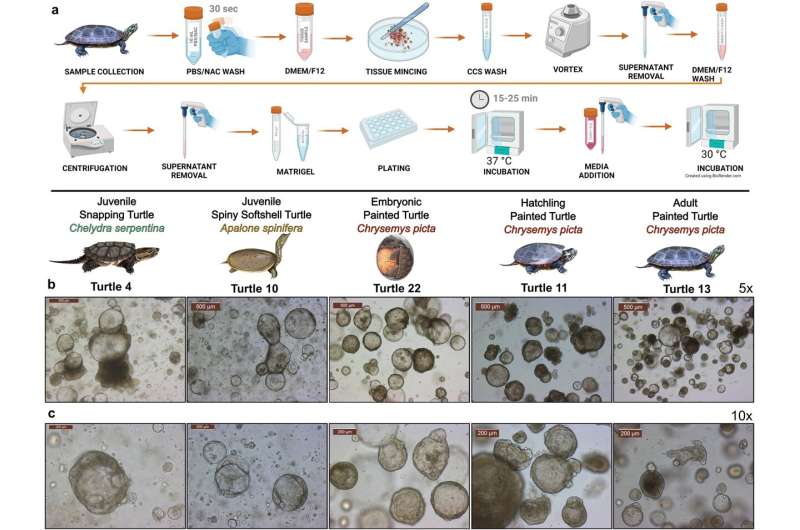This article has been reviewed according to Science X's editorial process and policies. Editors have highlighted the following attributes while ensuring the content's credibility:
fact-checked
peer-reviewed publication
trusted source
proofread
Lab-grown liver organoid to speed up turtle research and make useful traits easier to harness

At a Biotechnology Council event a few years ago, Nicole Valenzuela's ears perked up when she heard what a group of researchers in Iowa State University's College of Veterinary Medicine had in the works: a method for creating a lab-grown, simplified mimic of dog intestines.
"I told them, 'Oh! I want to do that, but with turtles. Is it doable?'" said Nicole Valenzuela, professor of ecology, evolution, and organismal biology at Iowa State.
It is indeed doable, new research from a team led by Valenzuela shows. The three-dimensional clusters grown from adult stem cells are called organoids and are designed to assist in research. In a paper published in Communications Biology, Valenzuela and her colleagues describe their creation of organoids that mimic a liver from three species of turtles. It's the first set of organoids developed for turtles and only the second for any reptile.
Studying turtle genetics with a liver organoid should speed up research to uncover the cause of turtle traits that could potentially have medical applications for humans—the ability of painted turtles to survive weeks without oxygen and withstand extreme cold, for instance.
"Some of their unique adaptations make painted turtles an interesting model for biomedicine. But they remain understudied because it's difficult work to do. The idea here is to eliminate that bottleneck," Valenzuela said.
Benefits of organoids
Valenzuela has been researching turtles for more than three decades, drawn to study these animals because of their temperature-dependent sex determination. In many turtles, colder eggs are more likely to produce males, while a warmer nest brings more females.
In studying the genetic causes of traits, biologists eventually need to validate their findings to confirm a gene is functioning as suspected. That requires manipulating those genes, which is a challenge with turtles because they reproduce seasonally and mature slowly, Valenzuela said.
"It's easy when you're working with fruit flies or flatworms, but doing transgenic experiments on turtles is pretty much impossible," she said.
That's part of why researchers are increasingly developing organoids, she said. The species- and organ-specific mimics expand the range for modern gene editing, allowing scientists to devote more attention to animals that are promising research targets but challenging to study.
"From a single chunk of tissue, you can have an unlimited source of experiment subjects and don't have to sample animals constantly. Organoids are an important technology for reducing live animal research," Valenzuela said.
Tweaking the recipe
Valenzuela's team built their process on the methods used by the research group in the College of Veterinary Medicine, whose work on organoids included a canine intestinal model for testing drug absorption rates. The leads on the canine intestine project—Karin Allenspach and Jon Mochel, now at the University of Georgia—also were part of the turtle organoid project. Recent ISU doctoral graduate Christopher Zdyrski was the first author of the turtle organoid paper.
Organoids are made by culturing a tissue sample in a solution that stimulates the production of stem cells, the special cells within a body responsible for repair and growth. Given the right fuel, turtle liver stem cells start making turtle liver cells. The microscopic ball of cells is hollow at first but less so as cells accumulate, Valenzuela said. A three-dimensional cluster is better than a flat layer of single cells at mimicking the complexity of actual tissue, even if not fully.
Valenzuela said her team chose to focus first on the liver because it plays a critical role in helping turtles survive extreme cold and oxygen deprivation. The liver produces proteins and enzymes to boost cellular defenses against freezing and provides the small amount of energy a turtle needs for anaerobic metabolism to survive without oxygen, using their shells and bones to manage the resulting lactic acid build-up.
Applying a process designed for dog intestines to a different organ in a different animal took some modification but not necessarily an overhaul, similar to swapping out ingredients in a recipe, she said.
"All of the discovery is in developing those protocols and in characterizing how similar the organoids are to the original liver tissue," she said.
What's next
Organoids generated by Valenzuela's team came from samples collected in Iowa from juvenile spiny softshell and snapping turtles as well as juvenile, adult, and embryonic painted turtles. Seeing success across multiple species and developmental stages suggests the techniques could be replicated broadly, she said.
Valenzuela's group is already at work on creating organoids from turtle gonads, to further investigate the underlying causes of sex determination. They're also hoping to study oxygen deprivation and resistance to cold using the novel turtle liver organoids.
But given the lack of genomic tools for studying reptiles—the only other known reptilian organoid is from snake venom glands, the researchers reported in their paper—Valenzuela is optimistic that her team's work will be used by herpetologists to expand their research.
"That's the hope, that other scientists adopt these protocols to study other reptiles," she said.
More information: Christopher Zdyrski et al, Establishment and characterization of turtle liver organoids provides a potential model to decode their unique adaptations, Communications Biology (2024). DOI: 10.1038/s42003-024-05818-1
Journal information: Communications Biology
Provided by Iowa State University





















